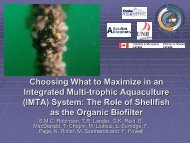Integrated multi-trophic aquaculture (IMTA) in marine temperate waters
Integrated multi-trophic aquaculture (IMTA) in marine temperate waters
Integrated multi-trophic aquaculture (IMTA) in marine temperate waters
Create successful ePaper yourself
Turn your PDF publications into a flip-book with our unique Google optimized e-Paper software.
<strong>Integrated</strong> <strong>multi</strong>-<strong>trophic</strong> <strong>aquaculture</strong> (<strong>IMTA</strong>) <strong>in</strong> mar<strong>in</strong>e <strong>temperate</strong> <strong>waters</strong> 23<br />
Gracilaria cornea up to 5 percent, of the diet for juvenile sea bass, thus provid<strong>in</strong>g<br />
another use for macroalgae grown <strong>in</strong> <strong>IMTA</strong> systems <strong>in</strong> Portuguese <strong>waters</strong>.<br />
France<br />
In 2004, mariculture <strong>in</strong> France produced 208 535 tonnes of shellfish, 7 653 tonnes of fish<br />
and 37 tonnes of seaweeds, with respective values of US$506 672 000, US$71 183 000 and<br />
US$16 000 (Table 1). Most <strong>aquaculture</strong> units <strong>in</strong> France are <strong>in</strong>tensive monocultures. The<br />
majority of the work on <strong>IMTA</strong> systems <strong>in</strong> France is concerned with the use of mar<strong>in</strong>e<br />
ponds to treat fish effluents, and all are at the experimental stage. More specifically,<br />
researchers (Pagand et al., 2000; Metaxa et al., 2006) are <strong>in</strong>vestigat<strong>in</strong>g the use of high<br />
rate algal ponds (HRAP) to treat sea bass (Dicentrarchus labrax) effluents and other<br />
researchers (Lefebvre, Barillé and Clerc, 2000) are <strong>in</strong>vestigat<strong>in</strong>g the use of oysters to<br />
treat sea bass effluent <strong>in</strong> a research <strong>in</strong>itiative known as the European Genesis project.<br />
Metaxa et al. (2006) found that when Ulva and Cladophora were used <strong>in</strong> HRAP the<br />
wastewater had significant reductions <strong>in</strong> the dissolved <strong>in</strong>organic N and P. The authors<br />
also noted that the algae had no effect on fish growth. An important observation<br />
made by these researchers is that the uptake of N and P by the algae was greater <strong>in</strong><br />
summer than w<strong>in</strong>ter; therefore farmers should consider seasonal effects on algal growth<br />
conditions and water effluent treatment <strong>in</strong> <strong>in</strong>tegrated units.<br />
Pagand et al. (2000) found that when Ulva (as Ulva and Enteromorpha) was used<br />
<strong>in</strong> HRAP the wastewater effluent had higher levels of dissolved oxygen and lower<br />
concentrations of nutrients and suspended solids than the water <strong>in</strong> reference tanks. No<br />
toxic algae were observed, and, as <strong>in</strong> the previous study, the authors noticed a profound<br />
seasonal effect on algal growth and production.<br />
Oysters are actively cultured <strong>in</strong> France, particularly <strong>in</strong> the Marennes-Oléron Bay.<br />
To assess the suitability of oysters to <strong>IMTA</strong> systems, Lefebvre, Barillé and Clerc (2000)<br />
<strong>in</strong>vestigated the ability of oyster (Crassostrea gigas) to clean sea bass (Dicentrarchus<br />
labrax) effluent. The authors found that Crassostrea gigas has the ability to feed on the<br />
detritus/waste of the fish farm effluent. This is one way that farmers can recapture the<br />
lost organic product of <strong>in</strong>tensive fish farm<strong>in</strong>g, and grow another economically valuable<br />
species.<br />
Although these studies are pond or tank based, they are all relevant to the mar<strong>in</strong>e-<br />
based <strong>aquaculture</strong> systems <strong>in</strong> coastal <strong>waters</strong> of France, specifically the <strong>aquaculture</strong> of<br />
sea bass. Therefore their importance to the development of <strong>IMTA</strong> systems, particularly<br />
the benefits of <strong>in</strong>tegrat<strong>in</strong>g macroalgae and oysters, <strong>in</strong> coastal <strong>waters</strong> should be justly<br />
noted.<br />
United K<strong>in</strong>gdom of Great Brita<strong>in</strong> and Ireland<br />
Aquaculture <strong>in</strong> the United K<strong>in</strong>gdom (essentially Scotland’s west coast) and Ireland<br />
primarily consists of monoculture units, with emphasis on salmonids and mussels. In<br />
Western Europe, the United K<strong>in</strong>gdom is second to Norway <strong>in</strong> <strong>aquaculture</strong> growth<br />
and makes up 17 percent of the region’s salmon production (FAO, 2006a). In 2004,<br />
the United K<strong>in</strong>gdom produced 160 319 tonnes of fish and 32 500 tonnes of shellfish,<br />
with respective values of US$483 873 000 and US$64 278 000 (Table 1). Ireland<br />
produced 43 092 tonnes of shellfish and 14 374 tonnes of fish, with respective values<br />
of US$53 423 000 and US$65 007 000 (Table 1). There is some research on <strong>IMTA</strong> <strong>in</strong><br />
Scottish and Irish <strong>waters</strong>.<br />
The growth and production of mussels (Mytilus edulis) with salmon (Salmo salar)<br />
<strong>in</strong> Scottish sea lochs was <strong>in</strong>vestigated by Stirl<strong>in</strong>g and Okumuş (1995). They found<br />
that mussels <strong>in</strong>tegrated with salmon had higher growth rates and had less depleted<br />
tissue reserves over the w<strong>in</strong>ter than those grown without salmon. This study suggests<br />
that mussels can be <strong>in</strong>tegrated with salmon <strong>in</strong> Scottish <strong>waters</strong> for <strong>in</strong>creased economic<br />
viability.



